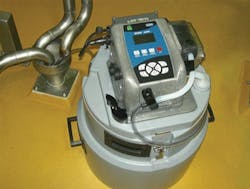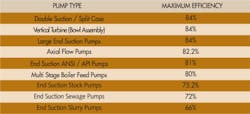Phosphorus Removal System Helps Town Exceed Water Quality Standards
By Jonathan Keaney
The Town of Maynard is a small community in eastern Massachusetts in the heart of what was once a thriving industrial center built around water-driven mills in the 19th and early 20th centuries on the Assabet River.
When the Environmental Protection Agency and Massachusetts Department of Environmental Protection (Mass DEP) set new nutrient limits to restore and protect the Assabet River, the town was faced with an updated NPDES permit with some of the lowest phosphorus limits in the entire country, 0.1 mg/L, including a provision for further potential reductions.
In 2005, the town completed a Comprehensive Wastewater Management Plan (CWMP) and selected CoMag (by Cambridge Water Technology) technology as the most cost-effective means of reaching the new limits. CoMag is a patented ballasted flocculation process that uses magnetite (Fe2O3) as the ballast. Brown and Caldwell was selected to implement the recommendation into a full design.
Challenges
The existing Wastewater Treatment Plant (WWTP) was last upgraded in 1986 as a full secondary treatment plant with Rotating Biological Contactors (RBC) as the secondary process. The plant is constrained in its current 2.5 acre footprint by surrounding properties and by the Assabet River. The facility had previously included aeration basins that had been converted to emergency holding tanks when the WWTP was modified to include RBCs. That was the only space available for construction or modification. The preliminary layout located the CoMag process inside the holding tanks with minimal modifications.
At the time of the design, the only operational experience with CoMag included pilot testing at a number of facilities and limited full scale operations at the nearby Concord WWTP. It was not clear what the real capabilities of the process were, specifically related to achieving sub 0.1 mg/L effluent phosphorus concentrations.
In addition to the phosphorus removal system, upgrades were required to most of the existing unit processes and a complete overhaul of the electrical and instrumentation infrastructure.
Sustainable Design
The Brown and Caldwell team designed for sustainability and efficiency. All possible steps were taken to optimize use of the existing facilities and flexible operations based on seasonal effluent permit requirements. The team collaborated with Cambridge Water Technology to apply lessons learned from the Concord WWTP and additional experiences from Brown and Caldwell design staff.
A review of the Concord WWTP identified a loss of performance at average or low flows and the negligible change in effluent phosphorus associated with the magnetic filter. A site visit revealed an effluent weir at the end of the final reaction tank with a substantial freefall, and extensive piping from the reaction tanks to the clarifiers.
The loss of performance at average flow at the Concord plant was attributed to de-flocculation as a result of the turbulence created by the overflow weir at the end of the final reaction tank. Brown and Caldwell determined that the process could be improved if a smooth, low velocity, low turbulence transition from the final reaction tank to the clarifier could be designed.
Based on the footprint required to house the CoMag process, the only viable space available was the abandoned aeration basin. To avoid the tank concerns at the Concord facility, a rectangular clarifier design was selected, with a submerged inlet weir as the transition between the final reaction tank and the tertiary clarifier. The rectangular geometry fit best within the existing structure and provided the ideal conditions for the submerged weir inlet configuration.
Key Design Features
Rectangular clarifiers to eliminate turbulent transitions. The rectangular configuration had the advantage of using an existing structure, improved equipment access, increased redundancy, and an increase in clarifier surface area. Most importantly, the layout eliminated the turbulent transition that impacted performance at the Concord plant. The rectangular design required a chain and flight sludge collection system. A non-metallic chain and flight would counteract any abrasive wear from the magnetite.
The cost of the concrete clarifiers and the chain and flight collector mechanisms was roughly equal to the cost of the proposed circular, free standing stainless steel clarifiers. An additional benefit of the rectangular clarifier and the submerged inlet weir transition from the final reaction tank was the elimination of significant piping and fittings and improved access to the entire clarifier area.
Dissipating baffle to counteract short circuiting. To address a concern raised about the potential for short circuiting at high flows across the surface of the clarifier, Brown and Caldwell applied an energy dissipating baffle, drawing upon a previous design applied in aerated grit tanks. The baffle wall was located approximately 1/3 of the way down the length of the clarifiers and consisted of a "picket fence" arrangement of vertical boards. The boards were intended to allow flow through without creating a scour but also enough energy dissipation to allow for improved settling at peak flows.
Multi-point chemical addition system to maximize operational control. A multi-point chemical addition system provided maximum flexibility and operational control. The feed locations for coagulant included the inlet of the primary clarifiers, the secondary clarifiers, and the inline static mixer installed upstream of the first CoMag reaction tank. Two-point chemical addition typically results in lower total chemical usage compared to single point addition.
The Concord plant was designed to operate year-round but concerns were raised by the town about the ability to operate cost effectively during the winter months when the effluent permit limit for phosphorus changed to 1.0 mg/L. The flexibility of the chemical addition system was designed for the seasonal permit requirements, allowing the plant to operate with a two-point addition scheme with or without the CoMag system online.
Results
Construction was completed in January 2011, with start-up on February 25th. Initial indications are that the design is highly successful in meeting its treatment objectives. During start up, the effluent limits of 0.1 mg/L were nearly being met without any magnetite addition. Eleven-day functional testing commenced on March 3, 2011.
At the peak flow during the testing, the solids loading to the CoMag system was three times greater than normal. During the functional testing, two-point chemical addition was implemented with coagulant added to the secondary clarifier influent and the CoMag influent. The process handed the extreme conditions very well.
The functional testing required that the process achieve an average effluent concentration of less than 0.1 mg/L. The average effluent concentration during the 11 days of functional testing was 0.026 mg/L of phosphorus. The average coagulant dose during the testing was 50 parts per million by volume (ppmv) at the secondary clarifier influent and 58 ppmv at the CoMag influent. The actual concentration of coagulant as measured by mg/L of aluminum was 3.5 and 4.0 respectively at the two feed locations.
The treatment plant was previously adding 400 gallons of ferrous sulfate to achieve an effluent phosphorus concentration of 0.7 mg/L. With the CoMag process, during the functional testing, the facility was using an average of 217 gallons per day to achieve less than 0.1 mg/L phosphorous.
The system also showed an exceptional ability to achieve low turbidity levels. During the functional testing, the average effluent turbidity was 0.26 NTU. The turbidity showed remarkable consistency even during periods of high flow and was the most immediate indication of the performance of the clarifiers.
The Town of Maynard assumed operation of the system the last week in March and their NPDES permit requirement for 0.1 mg/L effluent phosphorus took effect April 1. The performance in April continued the trend from the functional testing with an overall average effluent concentration of 0.057 mg/L phosphorous, even with chemical dosing adjusted by the town to minimize chemical costs. The system also improved the effluent quality related to total suspended solids and biochemical oxygen demand. The average effluent concentration of these two constituents for the month of April was 1.1 mg/L and 4.6 mg/L respectively. The effluent quality has resulted in a reduction in the amount of chemicals required for the disinfection process.
Conclusions
The limited data obtained up to this point suggests that the modifications to the first generation CoMag design were successful. The intent of the modifications was to enhance the process while making optimal use of the existing facilities. The plant's NPDES permit took effect on April 1, 2011, only two weeks after the functional testing was complete. The plant has been able to achieve effluent phosphorus concentrations well below permit, increasing operational flexibility and reducing chemical use. Working with Cambridge Water Technology staff, the Brown and Caldwell design allowed the town to comfortably meet future limits with limited additional investment and no major capital expenditures.
About the Author: Jonathan Keaney, P.E., is an engineer with Brown and Caldwell, in the firm's Boston office. He served as assistant project manager and project engineer on the Town of Maynard's Wastewater Treatment Plant improvements project.
More WaterWorld Current Issue Articles
More WaterWorld Archives Issue Articles


